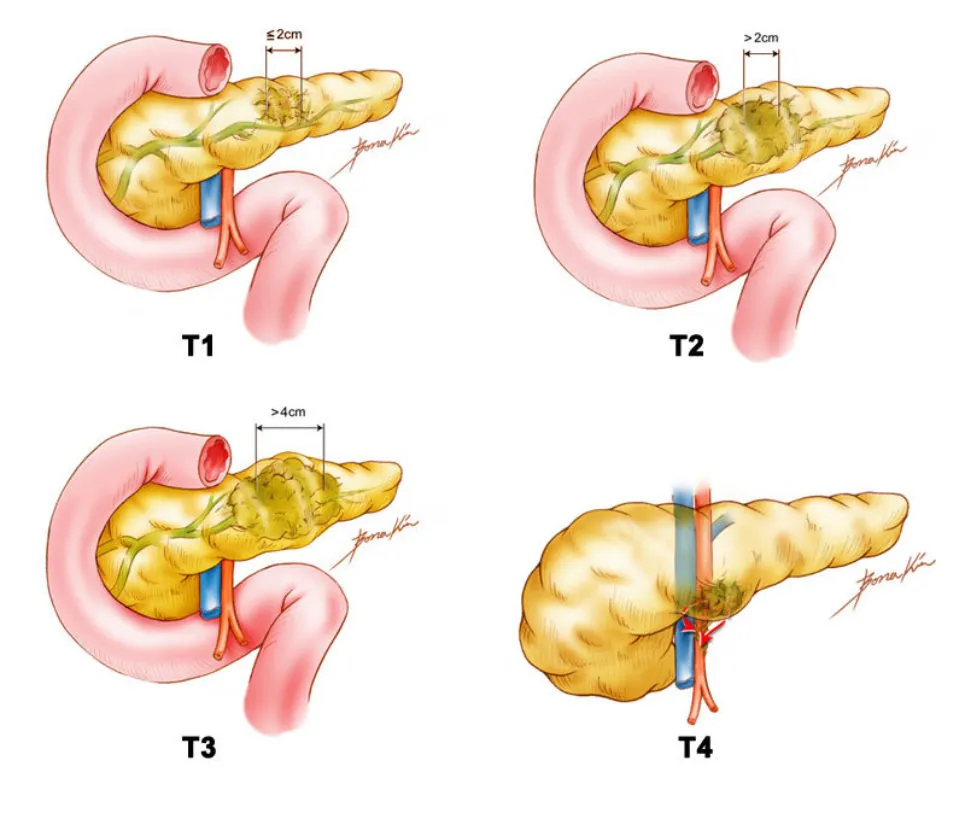Understanding Pancreatic Cancer Staging
Staging is crucial in understanding the severity of pancreatic cancer. It helps doctors determine the cancer's extent in the body when first diagnosed. The stage of the cancer is vital in planning the best treatment approach and predicting the likely outcome, or prognosis. Staging involves examining the tumor's size, its location, and whether it has spread to other parts of the body.
Video Credit: Animated Pancreas Patient
The TNM System: A Key Tool for Staging Pancreatic Cancer

A common method for staging pancreatic cancer is the TNM system, which stands for Tumor, Nodes, and Metastasis. This system looks at three key factors:
- Tumor (T): The size and extent of the main tumor.
- Nodes (N): Whether the cancer has spread to nearby lymph nodes.
- Metastasis (M): Whether the cancer has spread to distant parts of the body.
In addition to the TNM system, doctors often use a simpler clinical staging system based on whether the tumor can be surgically removed. This is an important distinction because pancreatic tumors can vary greatly in how they respond to surgery.
Surgical Resectability: Can the Tumour Be Removed?
Even with advanced diagnostic tests, determining the exact size and location of a pancreatic tumor can be challenging without surgery. As a result, pancreatic cancers are often categorized based on their resectability—meaning whether or not the tumour can be entirely removed with surgery.
Resectable Pancreatic Cancer
A tumour is considered resectable if it can be fully removed with surgery. In this case, the cancer is confined to the pancreas and has not spread to other parts of the body, a condition known as distant metastasis. Additionally, the tumor should not be in contact with major blood vessels like the superior mesenteric vein (SMV) or portal vein, nor should it be touching critical arteries such as the celiac axis, hepatic artery, or superior mesenteric artery (SMA).
Borderline Resectable Pancreatic Cancer
When a tumor is borderline resectable, it means that it has grown close to a major blood vessel, but it might still be possible to remove the tumor and reconstruct the affected vessel. For the tumor to be classified as borderline resectable, it should not have spread to distant parts of the body. However, it may be touching or pressing against the SMV or portal vein, and doctors might be able to safely remove the tumor and reconstruct the vein. The tumor could also be near or touching the hepatic artery without extending to the celiac axis or could be adjacent to the SMA without growing into it.
Unresectable Pancreatic Cancer
A tumor is deemed unresectable if it cannot be completely removed through surgery. This can occur for one of two reasons:
- Locally Advanced Pancreatic Cancer: The cancer has grown too deeply into nearby blood vessels or tissues to be fully removed, but it has not yet spread to distant organs or tissues.
- Metastatic Pancreatic Cancer: The cancer has spread to distant organs, making surgical removal of the primary tumor ineffective.
The TNM Stages of Pancreatic Cancer
Pancreatic cancer is classified into five stages within the TNM system, ranging from stage 0 to stage 4. Generally, the higher the stage, the more the cancer has spread. Here is a breakdown of each stage:
Stage 0: Carcinoma In Situ
In stage 0, the cancer cells are found only in the lining of the pancreas. This is the earliest stage and is sometimes referred to as carcinoma in situ.
Stage 1: Early-Stage Pancreatic Cancer
At stage 1, the tumor is confined to the pancreas and is relatively small. Stage 1 is further divided into:
- Stage 1A: The tumor is 2 cm or smaller.
- Stage 1B: The tumor is larger than 2 cm but not more than 4 cm.
Stage 2: Locally Advanced Cancer
Stage 2 pancreatic cancer is characterized by a tumor larger than 4 cm or by a tumor of any size that has spread to nearby lymph nodes. This stage is divided into:
- Stage 2A: The tumor is larger than 4 cm.
- Stage 2B: The tumor is of any size and the cancer has spread to 1 to 3 nearby lymph nodes.
Stage 3: Advanced Local Spread
In stage 3, the cancer has either spread to four or more nearby lymph nodes or has grown into large blood vessels outside the pancreas. The cancer may also have spread to nearby lymph nodes.
Stage 4: Metastatic Cancer
Stage 4 pancreatic cancer is the most advanced stage, where the cancer has spread to distant parts of the body, such as the liver, lungs, or abdominal cavity. This stage is also known as metastatic pancreatic cancer.
Recurrent Pancreatic Cancer
Recurrent pancreatic cancer refers to cancer that has returned after treatment. The recurrence can occur in different ways:
- Local Recurrence: The cancer comes back in the same place where it first developed.
- Regional Recurrence: The cancer returns in tissues or lymph nodes close to where it first started.
- Distant Recurrence: The cancer reappears in another part of the body, which is also called distant metastasis.
Understanding the stage of pancreatic cancer is crucial in guiding treatment options and giving a clearer picture of what to expect. Each stage presents different challenges and requires a tailored approach to treatment. If you have any questions about the staging of pancreatic cancer, it's important to discuss them with your healthcare provider. They can give you more detailed information specific to your condition and help you navigate the next steps in your treatment journey.
How Many Stages of Pancreatic Cancer are there?
There are five stages of pancreatic cancer, ranging from stage 0 to stage 4. These stages are determined using the TNM system, which assesses the tumor's size, lymph node involvement, and whether the cancer has spread to other parts of the body.
What Stage is most common?
In general, when Cancer is caught at stages, it has more treatment options and better outcomes. Unfortunately with Pancreatic Cancer, the majority of people are already stage IV.
Pancreatic Cancer Stage vs Grade: Whats the difference?
The stage and grade of Pancreatic Cancer are both equally important and despite the fact they sound quite similar, each refers to a different aspect of Pancreatic Cancer.
The stage refers to the extent to which the cancer has spread in the body. When we’re talking about grade we are referring to how quickly and likely the cancer is to spread.
Reference List 📚
- "Pancreatic Cancer Stages." Johns Hopkins Medicine, https://www.hopkinsmedicine.org/health/conditions-and-diseases/pancreatic-cancer/pancreatic-cancer-stages.
- "Pancreatic Cancer Stages." American Cancer Society, https://www.cancer.org/cancer/types/pancreatic-cancer/detection-diagnosis-staging/staging.html.
- "Nationwide Validation of the 8th American Joint Committee." National Center for Biotechnology Information, https://www.ncbi.nlm.nih.gov/pmc/articles/PMC9356941/.
- "Stages of Pancreatic Cancer." Canadian Cancer Society, https://cancer.ca/en/cancer-information/cancer-types/pancreatic/staging.
- "The American Joint Committee on Cancer 8th Edition Staging System." National Center for Biotechnology Information, https://www.ncbi.nlm.nih.gov/pmc/articles/PMC7026799/.
- "Pancreatic Cancer Staging." Medscape Reference, https://emedicine.medscape.com/article/2007121-overview.
- "Stages, Types and Grades of Pancreatic Cancer." Cancer Research UK, https://www.cancerresearchuk.org/about-cancer/pancreatic-cancer/stages-types-grades.
- "A New Staging System for Postoperative Prognostication." National Center for Biotechnology Information, https://www.ncbi.nlm.nih.gov/pmc/articles/PMC10469961/.
- "Stage Classification and Prognosis Assessment in Localized Pancreatic Cancer." American Society of Clinical Oncology, https://ascopubs.org/doi/10.1200/JCO.23.02494.
- "Pancreatic Cancer (Staging)." Radiopaedia, https://radiopaedia.org/articles/pancreatic-cancer-staging.







